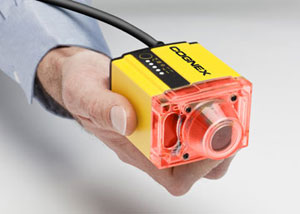March 8, 2011

Thenew DataMan 500 image-basedbarcode reader from Cognex Corporation uses Vision-System-On-Chip technology (VSoC)to achieve higher read rates, improved on-line visualization and higherreliability than laser scanners currently in use in the logistics, postal andretail distribution markets.
"Froman innovation standpoint, what we wanted to do for image-based 1D barcode readingis set a new standard from a read rate perspective," says John Keating, managerof product marketing at Cognex Corp. "As we set the stage to go after themid-range logistics market typically served by omnidirectional laser scanners,there were no image based products because of the technology barriers."
Thetechnological innovation behind the DataMan 500 product is the ability to readfull frame images and demonstrate 90 frames/sec reads without requiring anexternal sensor to trigger the reader. It is also the first incarnation of VSoCwhich marries new technologies for image acquisition and processing withcompany's IDMax software.
Image-Based Barcode Readers_A |
Onecurrent trend from a demand and throughput perspective is that read rates andthe expectation of higher read rates are increasing. Many customers using lasertechnology have been accepting low to mid-90 percent read rates. Often in the industry,96 percent is viewed as good performance when read rates of 99 percent plus canbe seen as an achievable goal with image-based reading.
Withthe drive to higher throughput, any time there is a "no read" condition,product is stacking up and impact operations. These drivers are pushingsuppliers to innovate, and to determine how to get image-based technology ableto achieve a price point where users can replace low cost lasers. A secondchallenge is that image-based readers have historically been up against atechnology barrier where a CCD or CMOS sensor transfers an image to a DSP, butit is difficult to effectively process the image.
Evenwith the most cost effective cameras that operate at 30-60 frames per sec, costeffective DSPs can't crunch through that data fast enough to do omnidirectionalreading at the highest conveyor rates. It has limited use of image-based readersunless customers moved to more costly line scan technology.
Cognexhas spent a number of years developing the VSoC technology to break throughthese barriers. The system is able to take pictures fast enough to keep up withconveyors going at 400 ft/min. But it can also perform dynamic light variationon-the-fly, so that as a bright or dark object goes through the view, theinternal illumination can change fast enough at 1,000 fps to get a good pictureand to be able to find the bar codes right on the silicon.
"VSoCtechnology is the key development because we designed the silicon from scratchand created a vision imager versus taking off-the-shelf products and using themfor machine vision," says Keating. "It was also implemented to support onboardprogramming, so that as the unit is reading, processing can be done on thechip."
"Oneof the hardest things to do with bar coding is first to find the code in thefield of view. Being able to do that on the chip makes the DSP's job mucheasier because it receives a small picture with an image of a bar code area tointerpret," he adds.
Nowapplications can achieve really high rates of speed with image based readers,and be effectively used for high speed lines. But it turns out that some of thebest reactions to the product have been in "presentation reading" situationswhere there is a need to pass an object by the scanner and have the system readthe code reliably without reading it multiple times. The DataMan 500 has thatability because it reads fast enough to know if the bar code has left its zone.
"Whenit comes to throughput requirements, the faster you can process codes, thefaster the product will move out the door," says Keating. "The read rate of theDataMan 500 has created a positive reaction in the market but it is the readrate at the higher speeds that is unprecedented."
Anotherimportant trend for bar code readers is the ability to add a 2D code fortracking and traceability which creates a way to future proof the product andto migrate from 1D to 2D safely in the future. The DataMan 500 provides asolution because of its ability to do both 1D and 2D reading because it is an image-basedreader.
Onthe second or third shift, there might be an issue on the line but personnelwould need to call someone in to find out what was going on. On a no-read,being able to archive the image and send the image to another location providesan ability for someone remotely to look at the image and find out that therewas, for example, no label or the label was folded over. Being able to archiveand understand better what is going on. The challenge of improving a 95 percentread rate is not only to read more difficult to read codes, but also tounderstand the read failures. But, often customers have no idea what is causingthe reduced read rate. They are unable to quantify why the laser didn't readthe code properly because they can't figure out what it saw.
UsingIDMax code reading software, DataMan 500 achieves higher read rates by readingthe 1D barcodes that laser readers cannot read including damaged, distorted,blurred, scratched, low height and low contrast codes. It processes images atup to 1,000 frames per second and can read codes in any orientation, 2D codessuch as Data Matrix and QR and multiple codes in the same image.
About the Author(s)
You May Also Like







